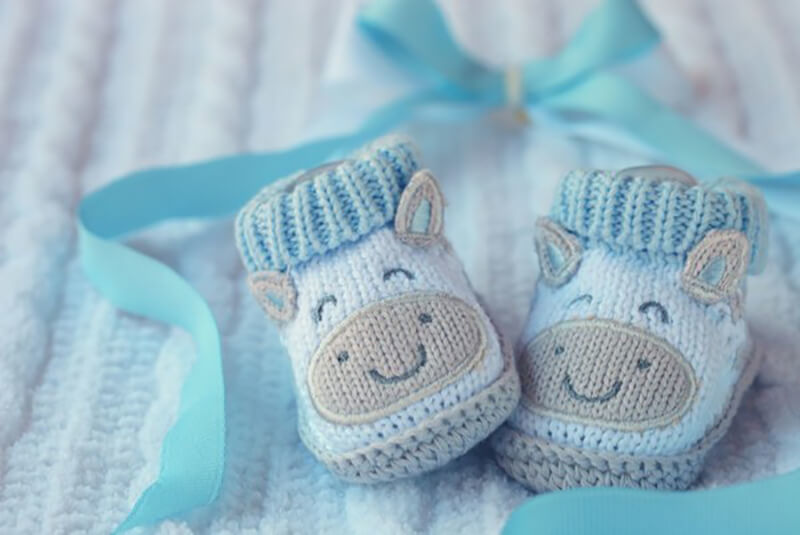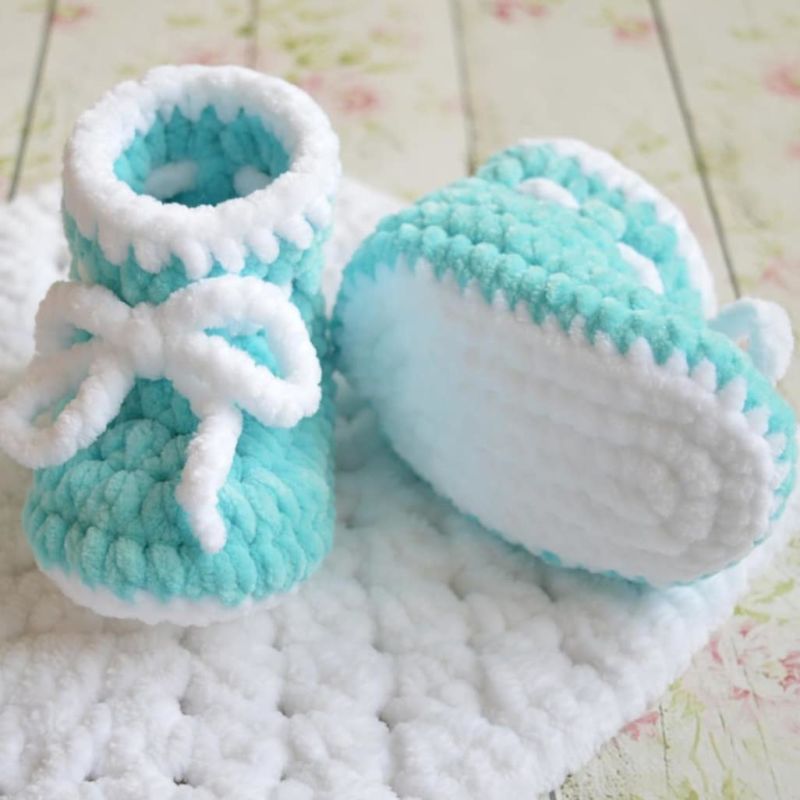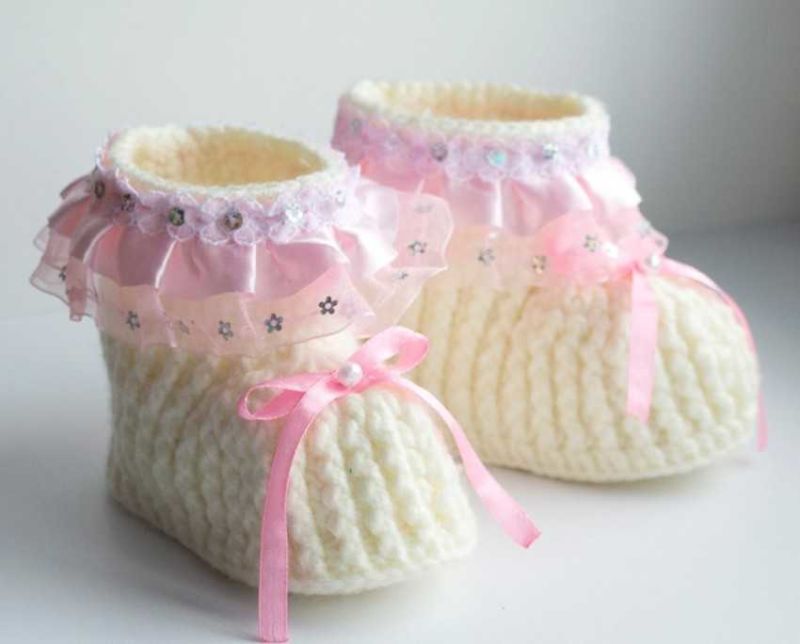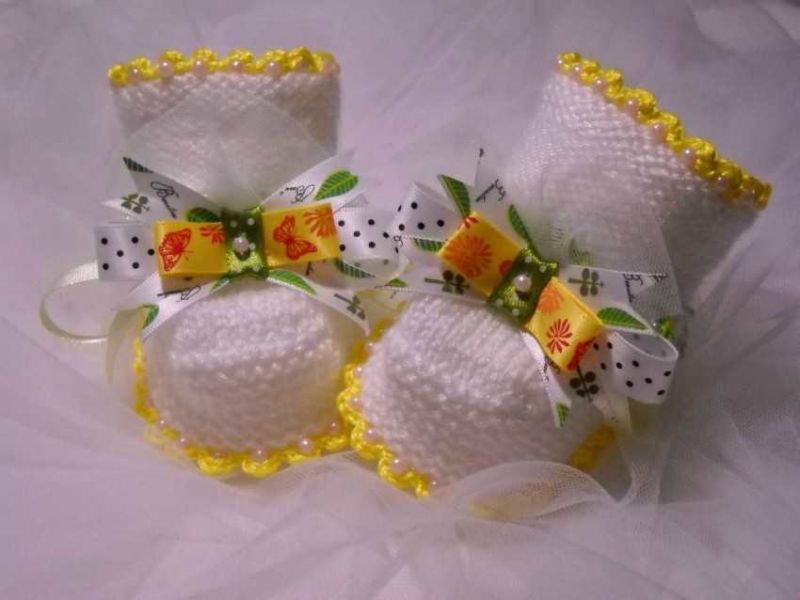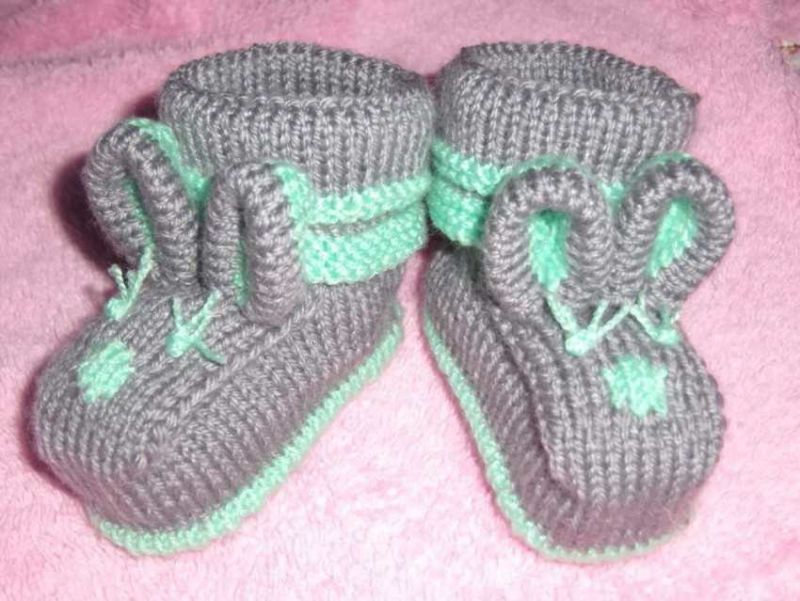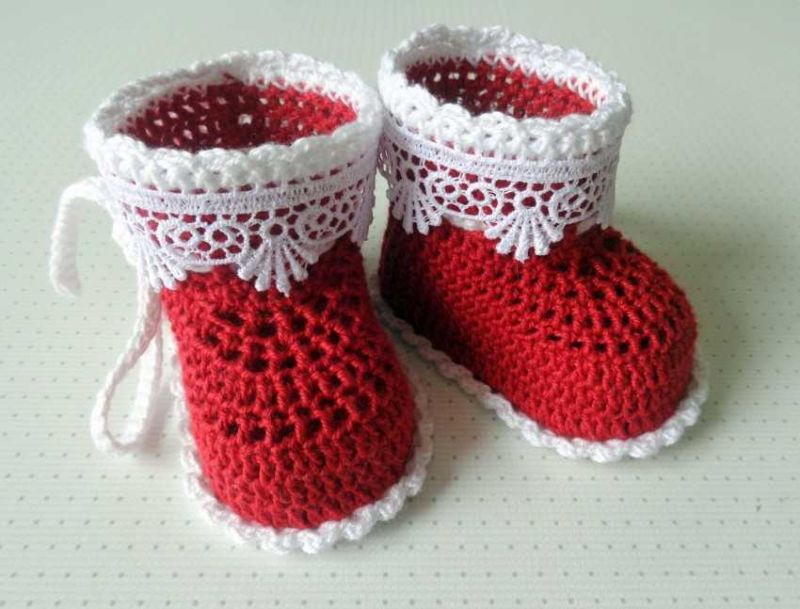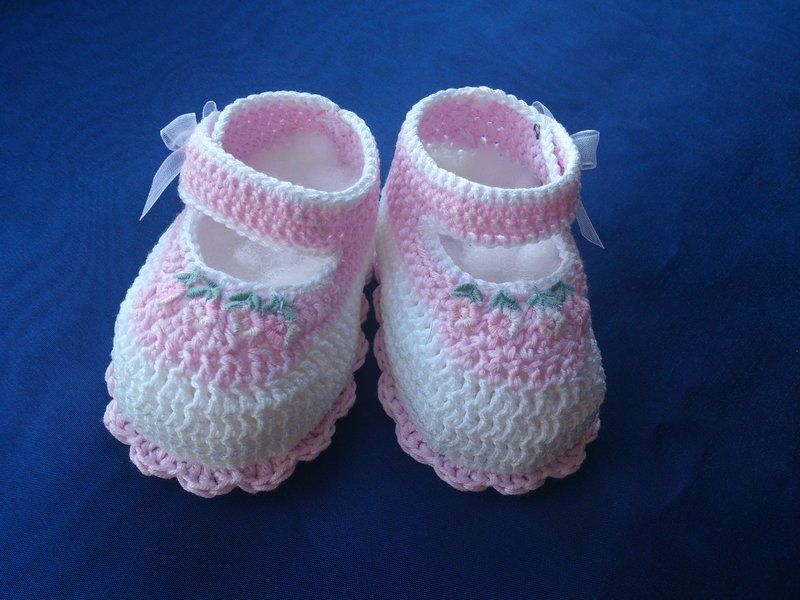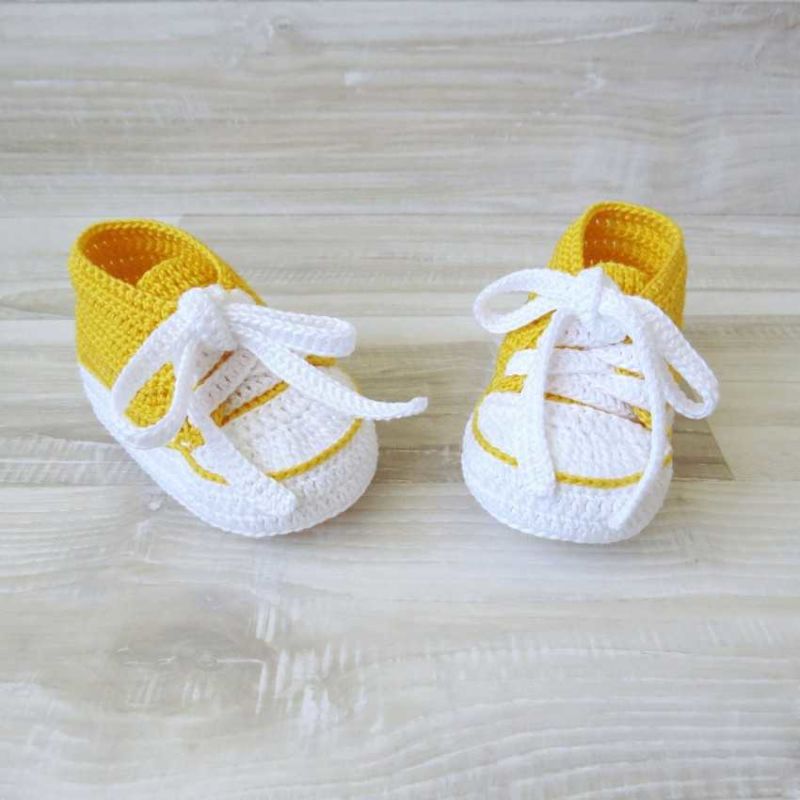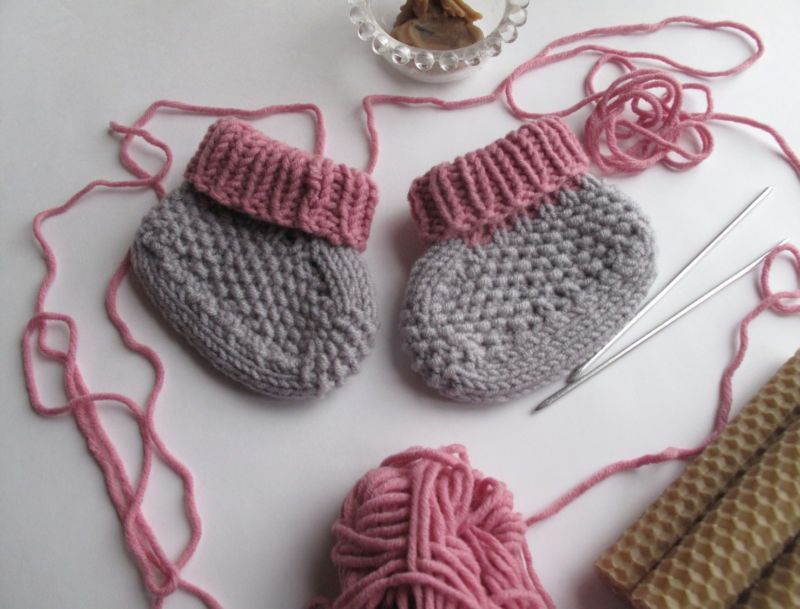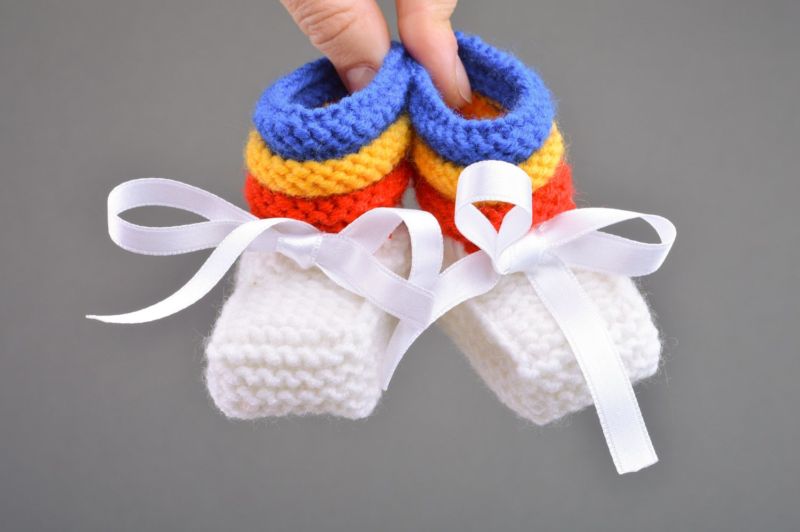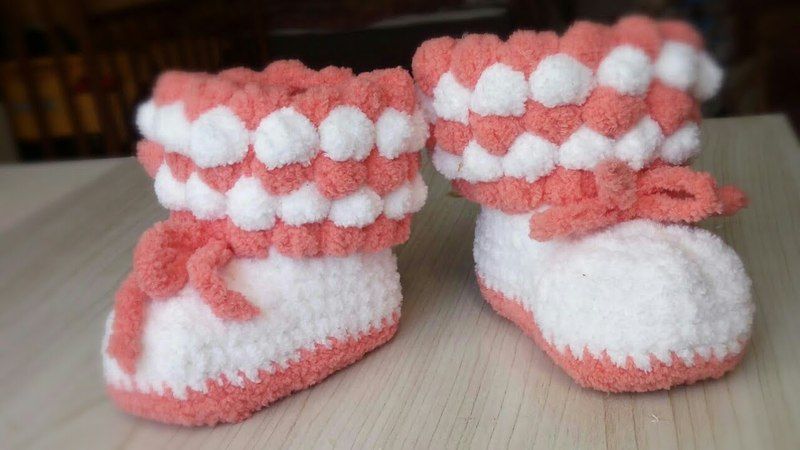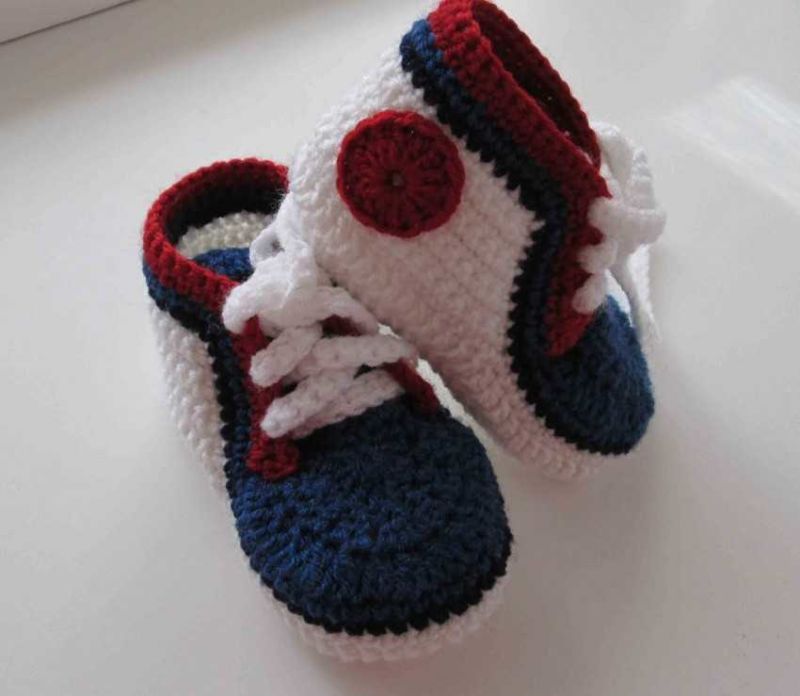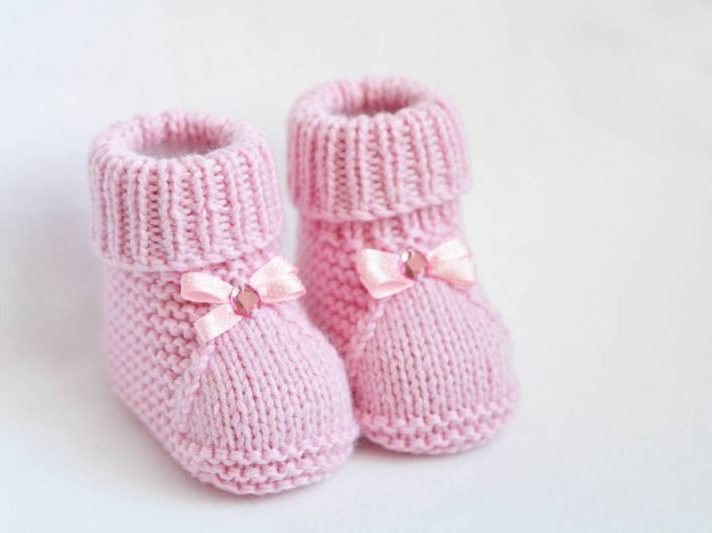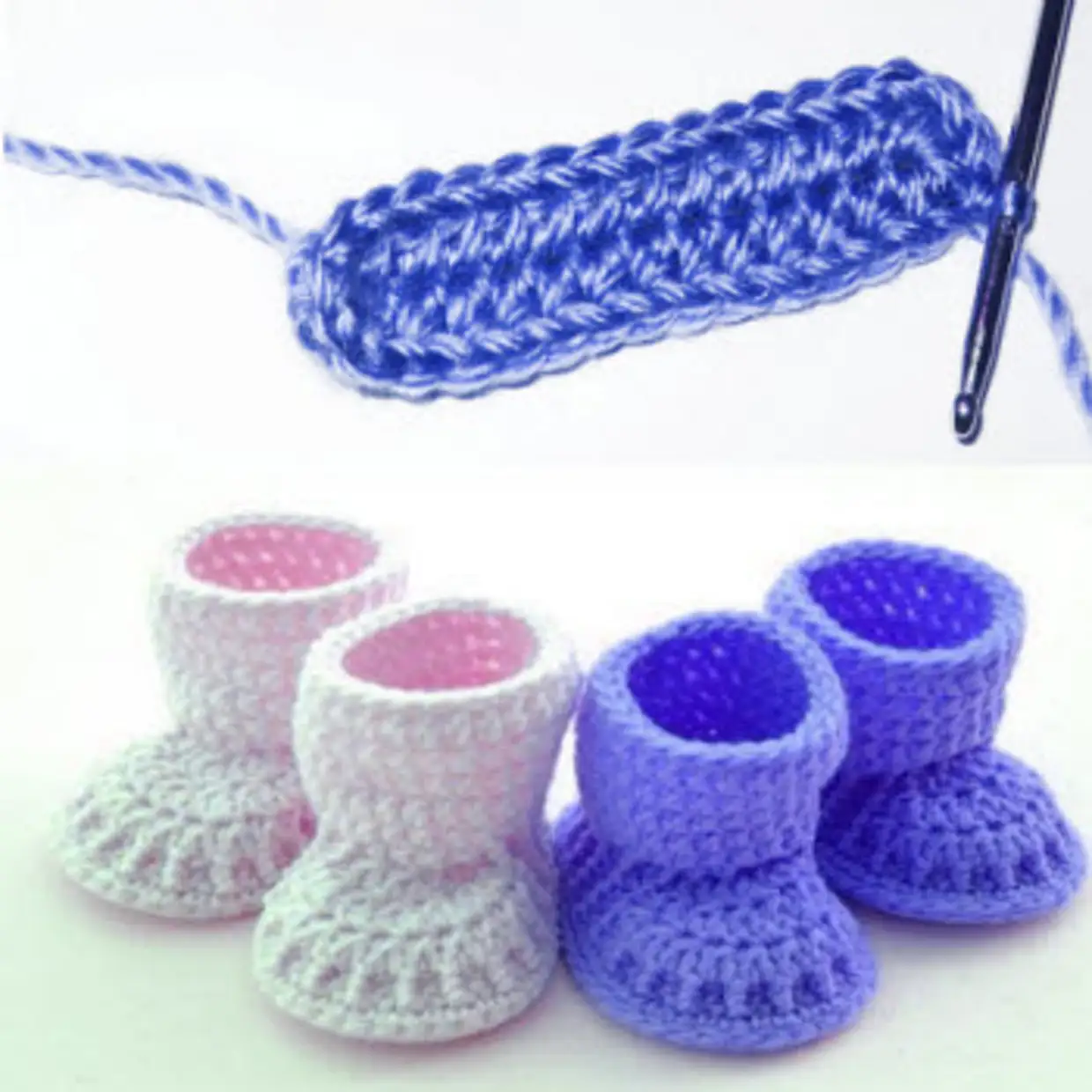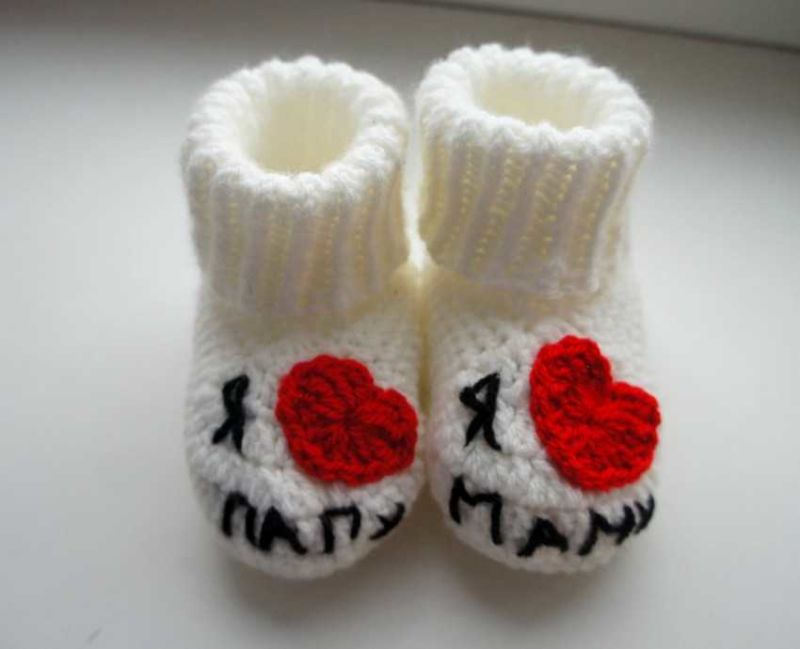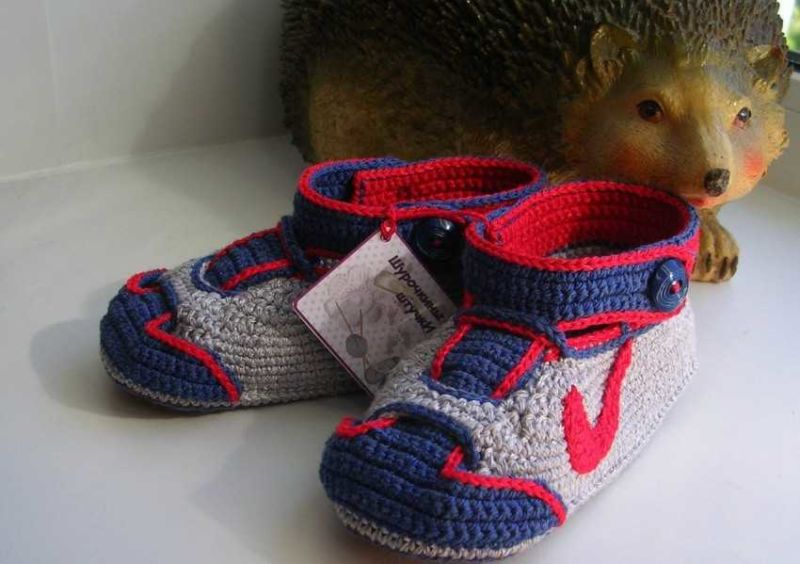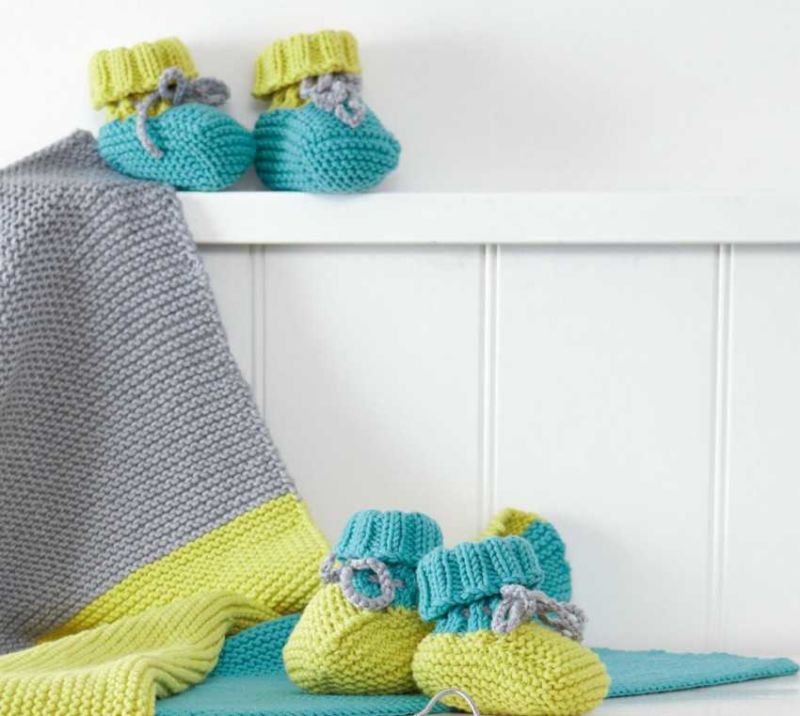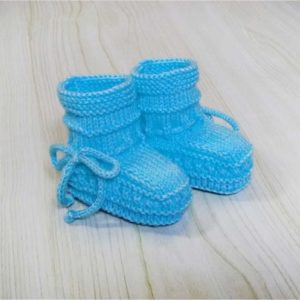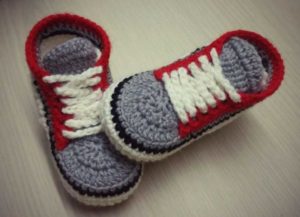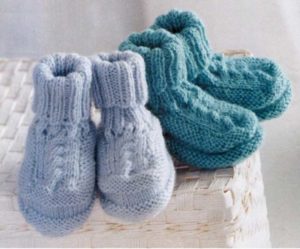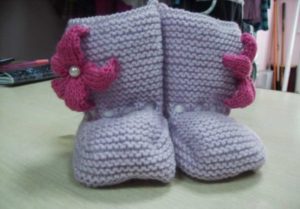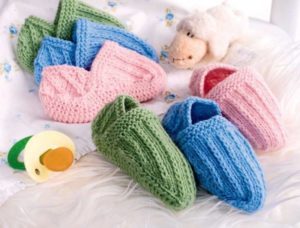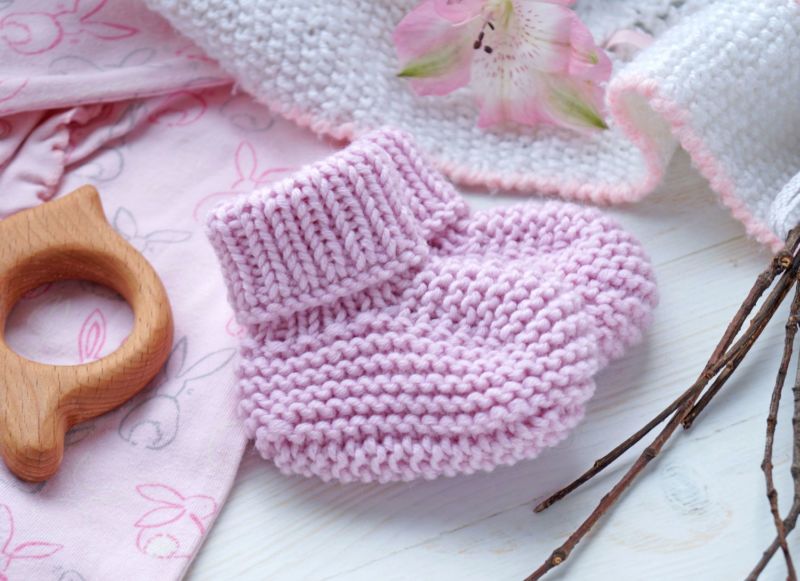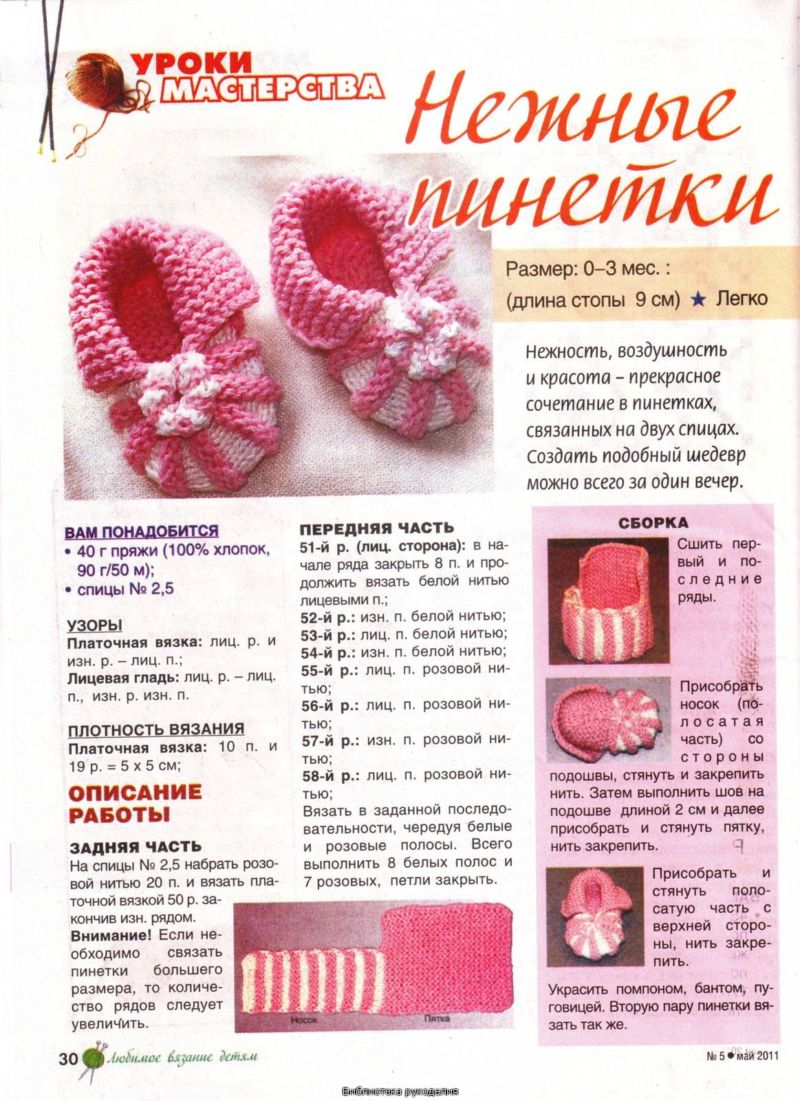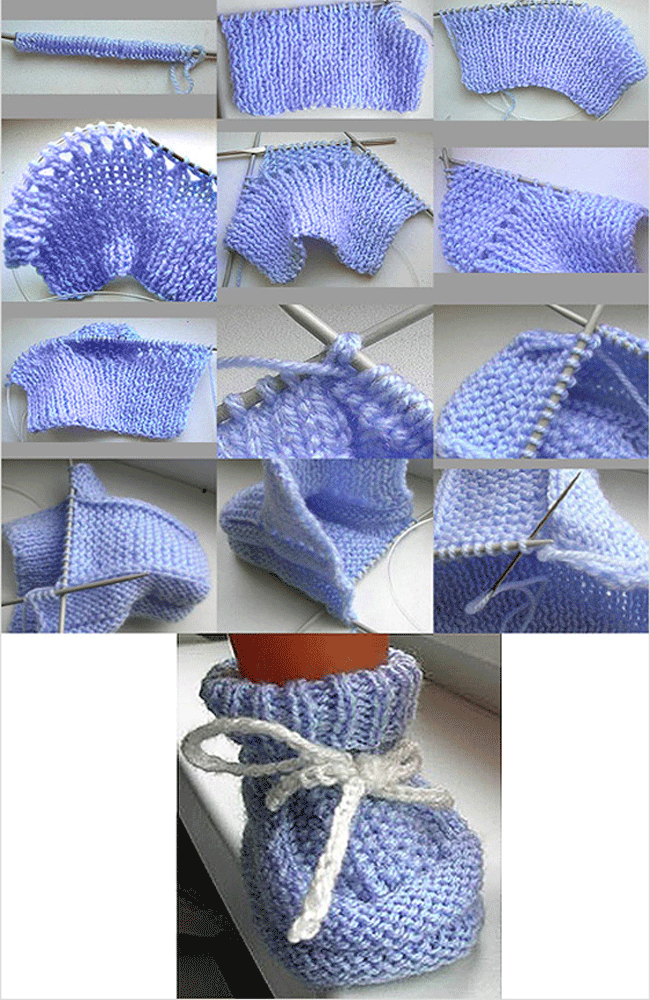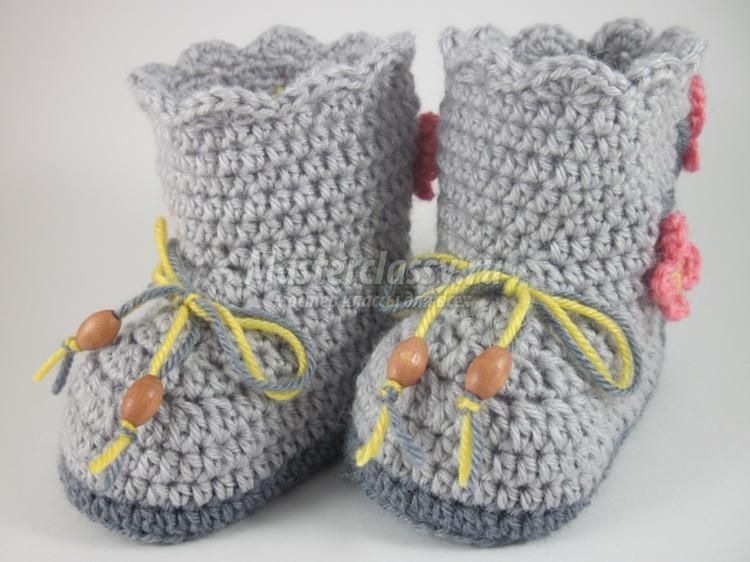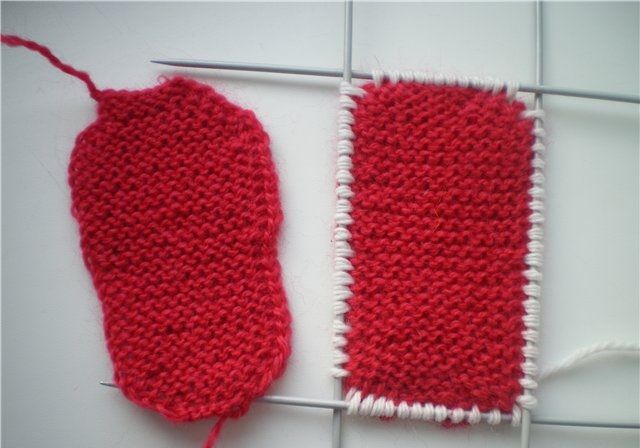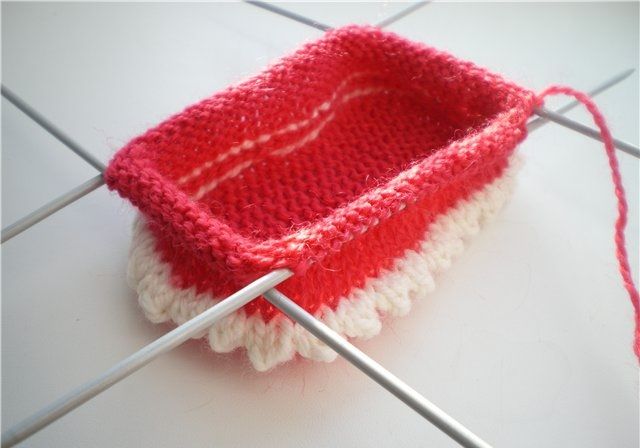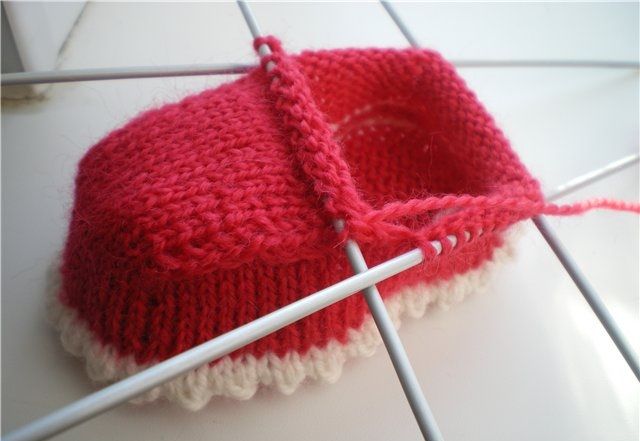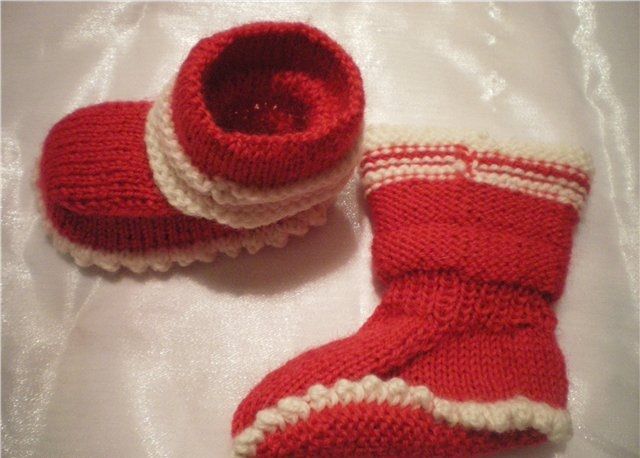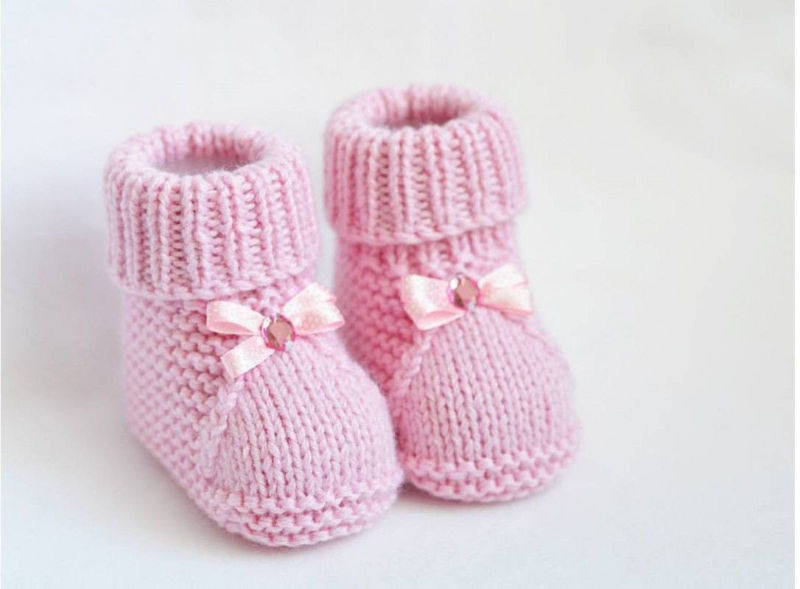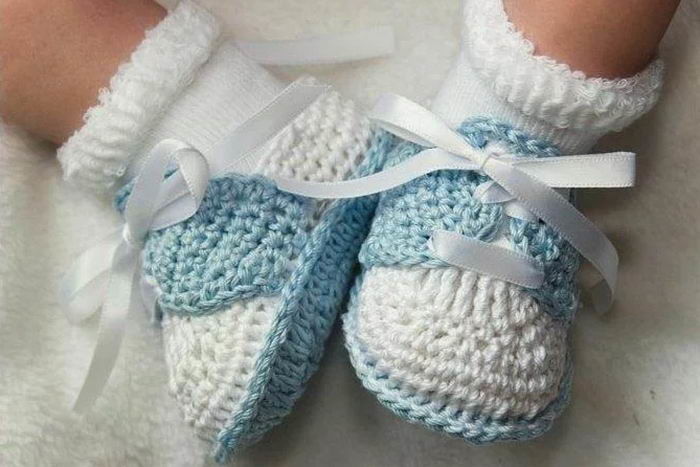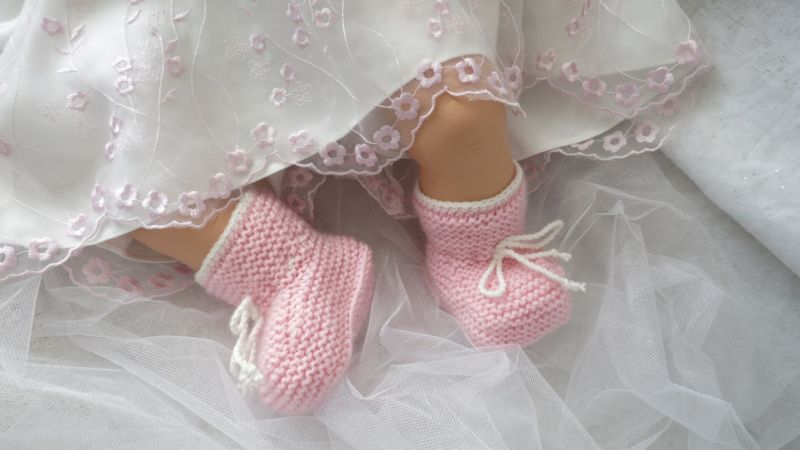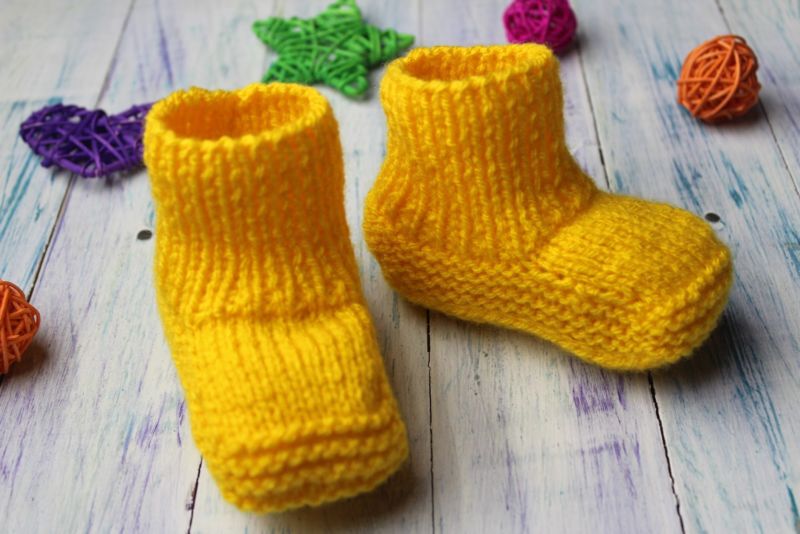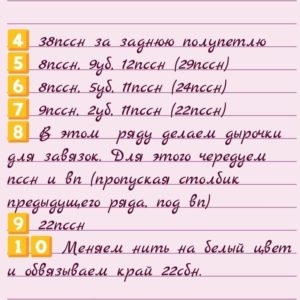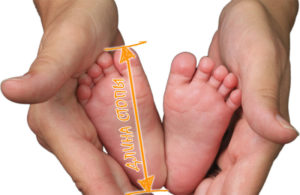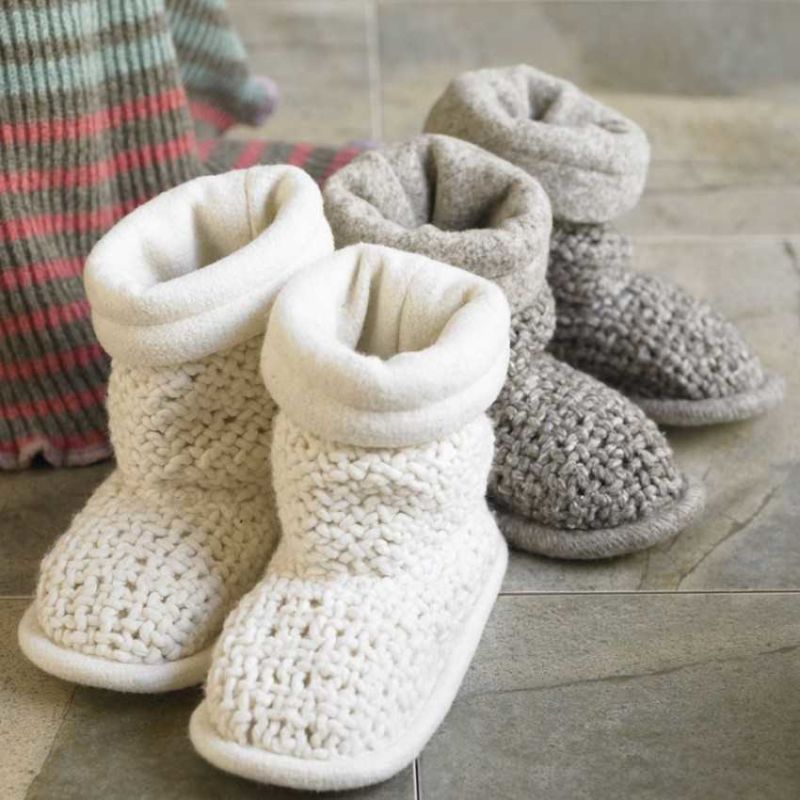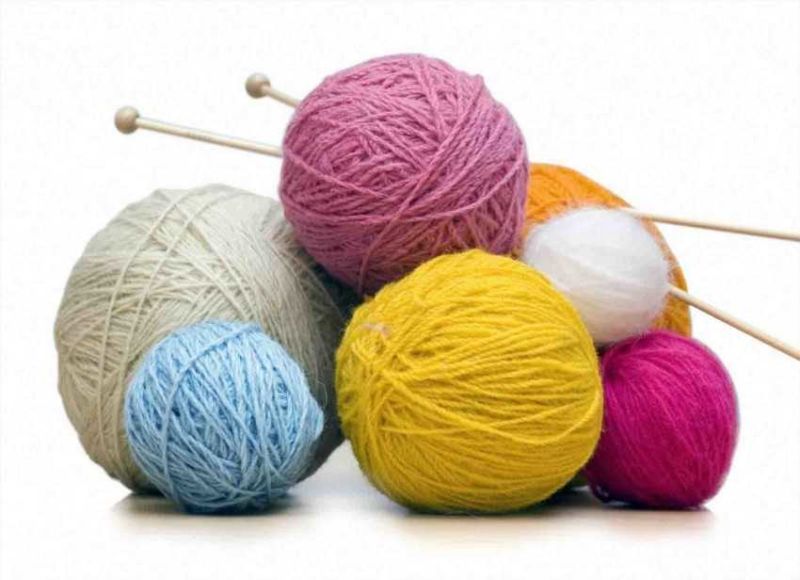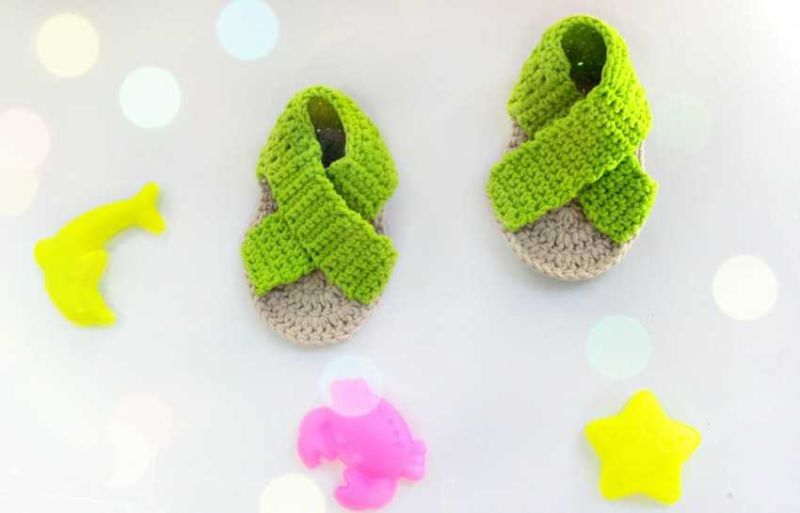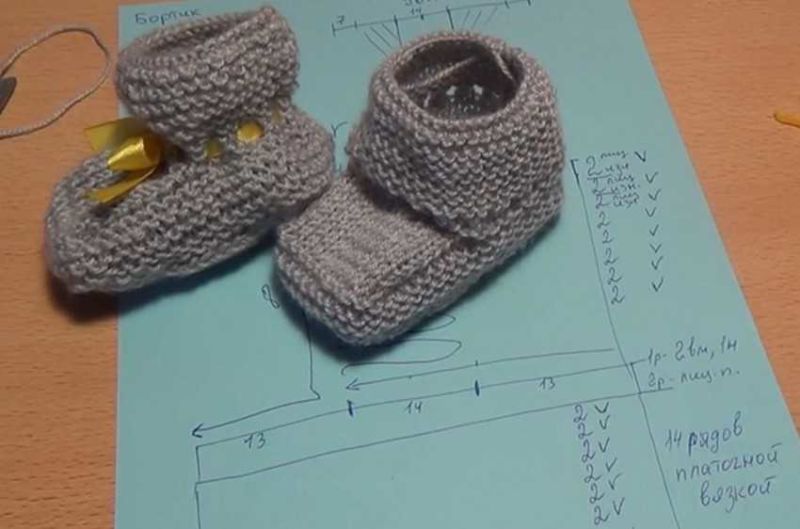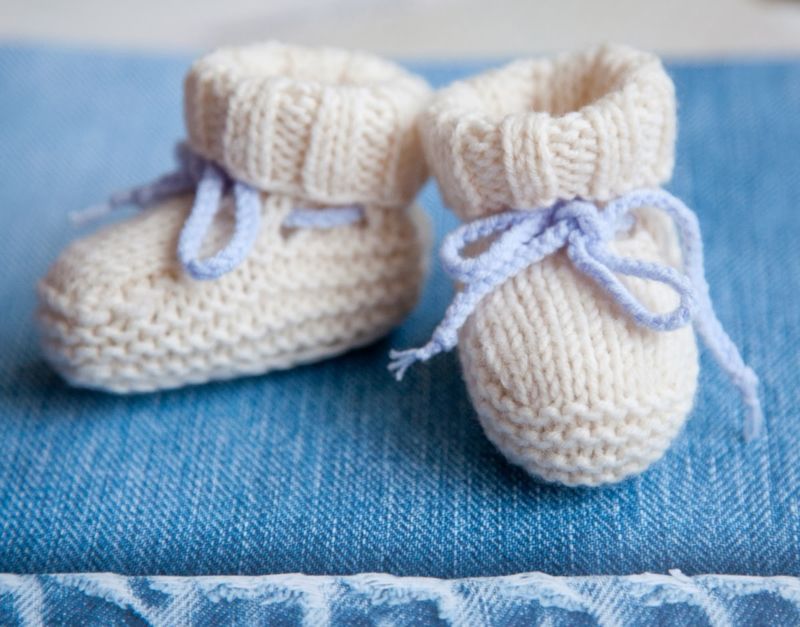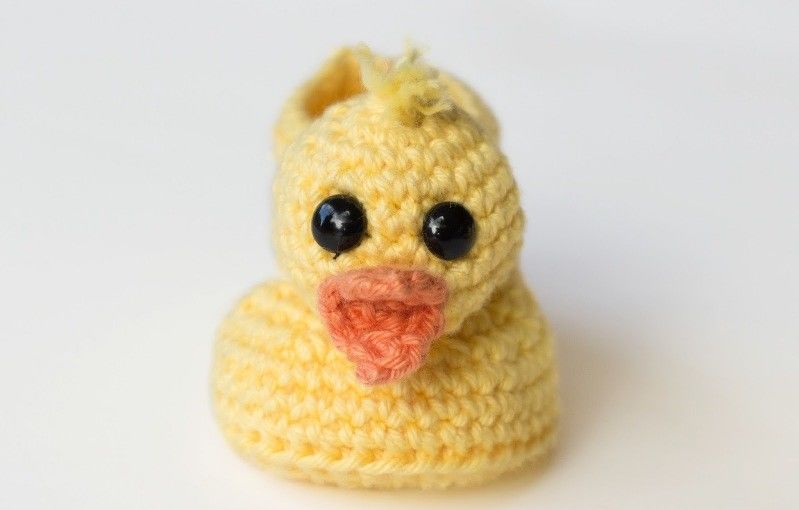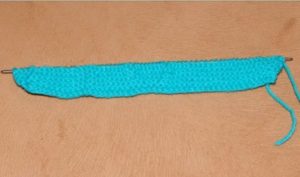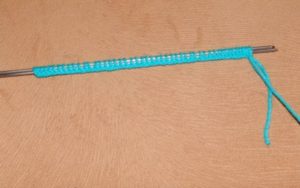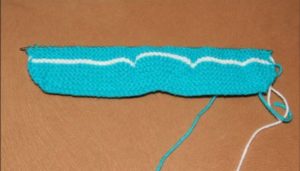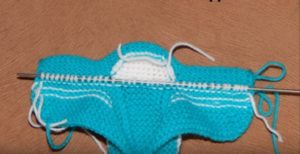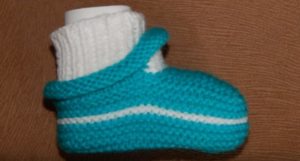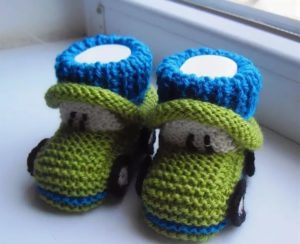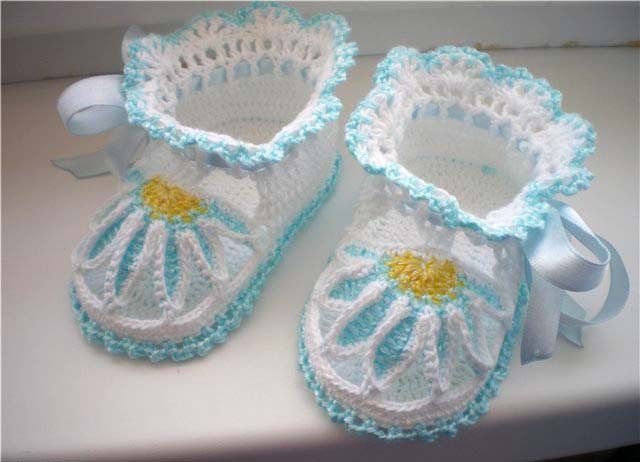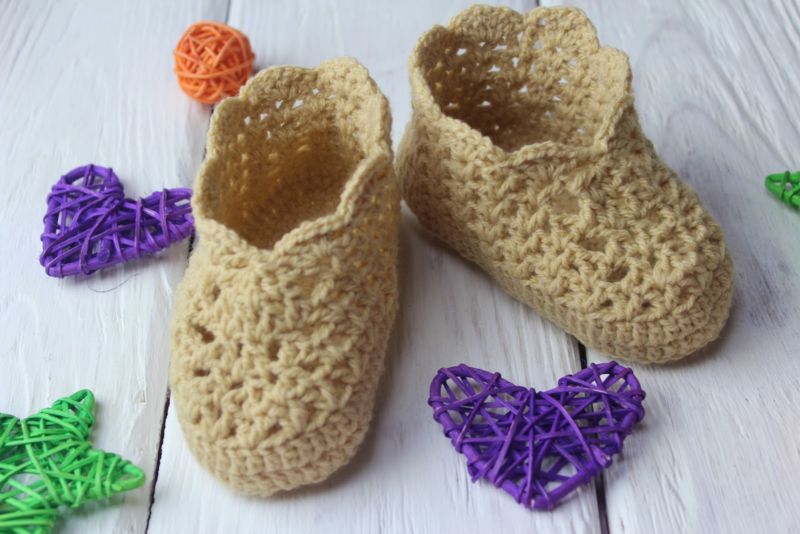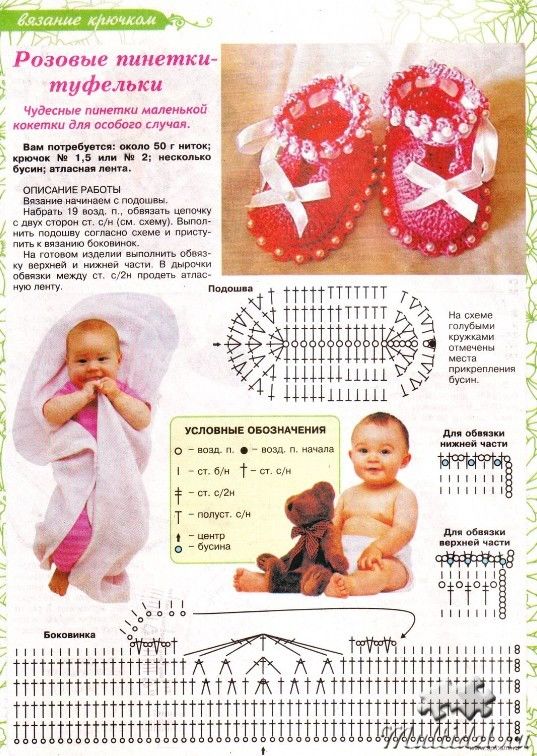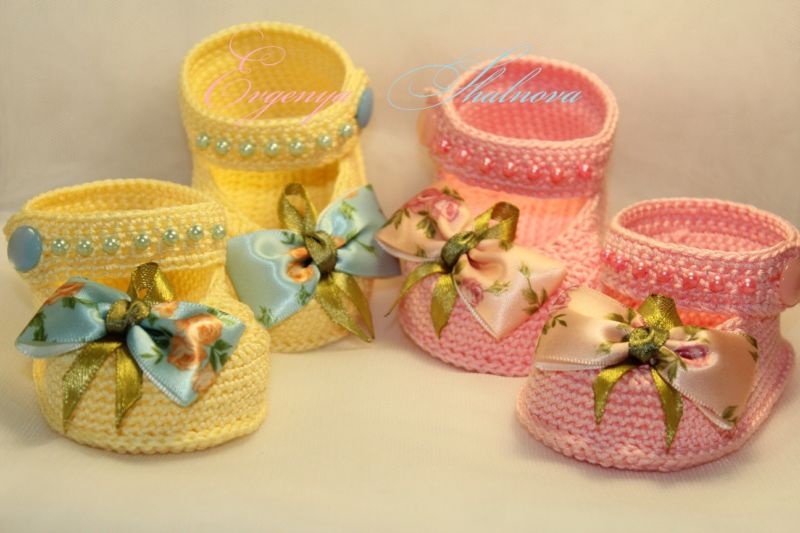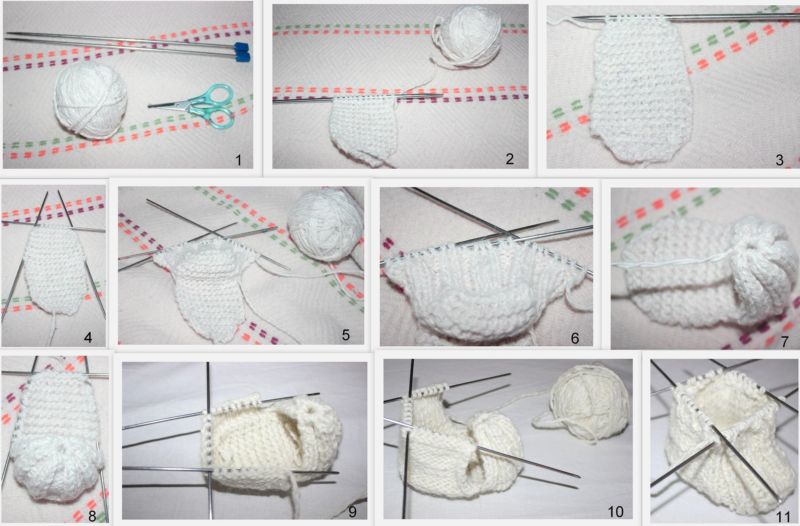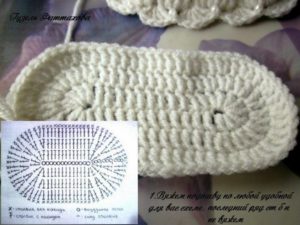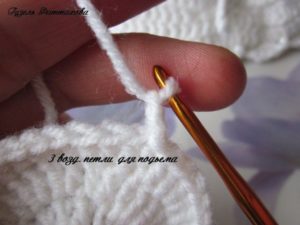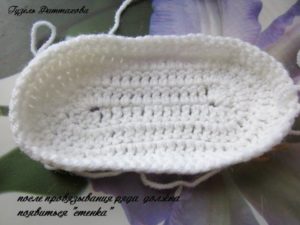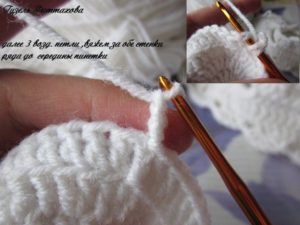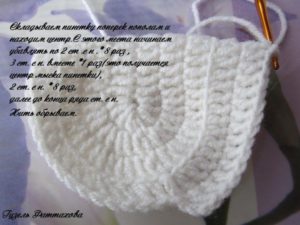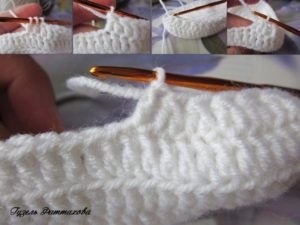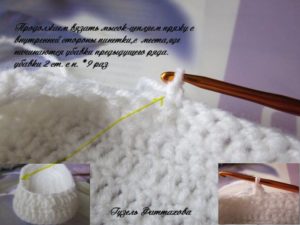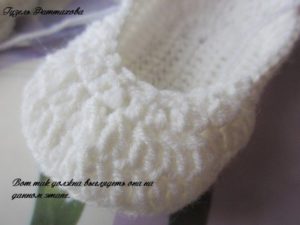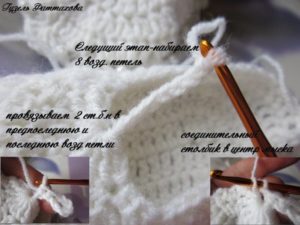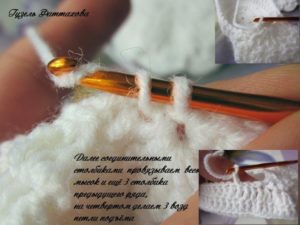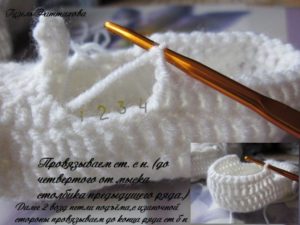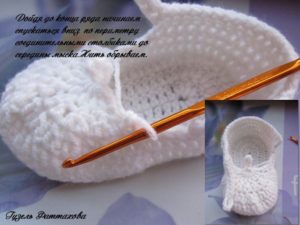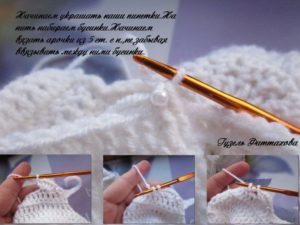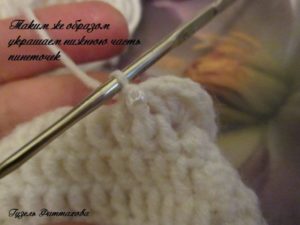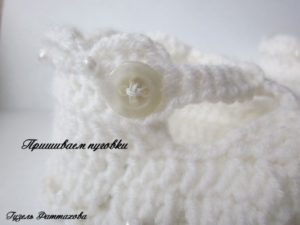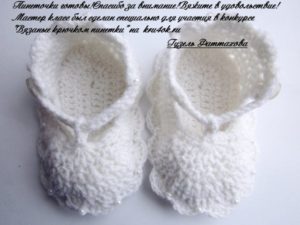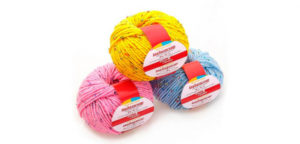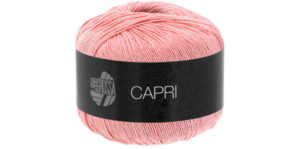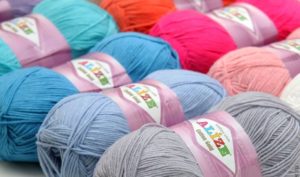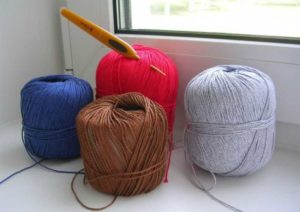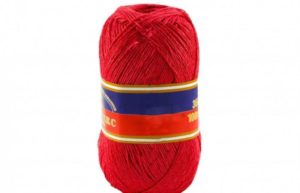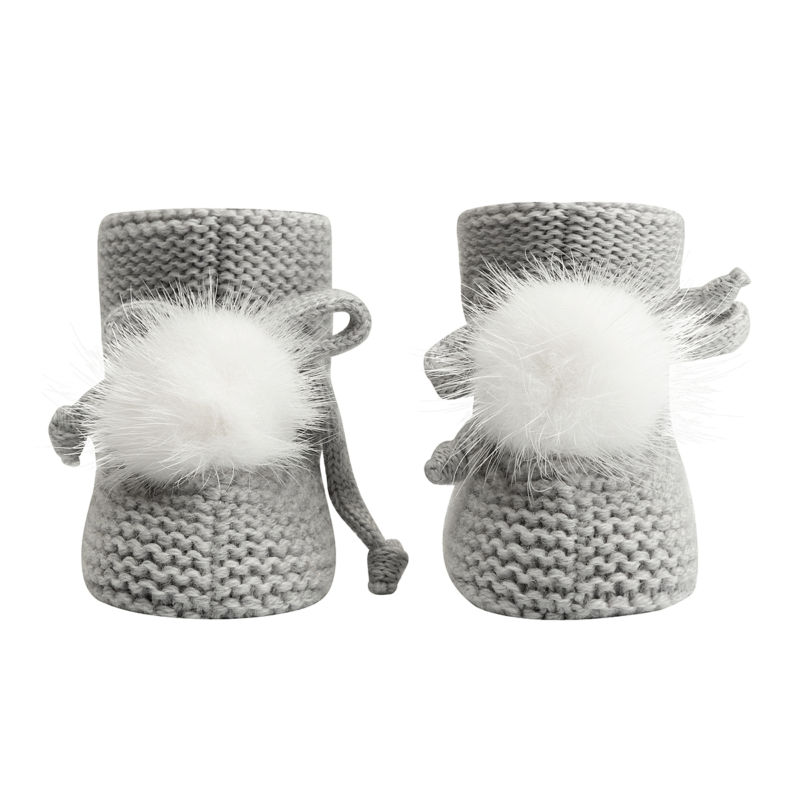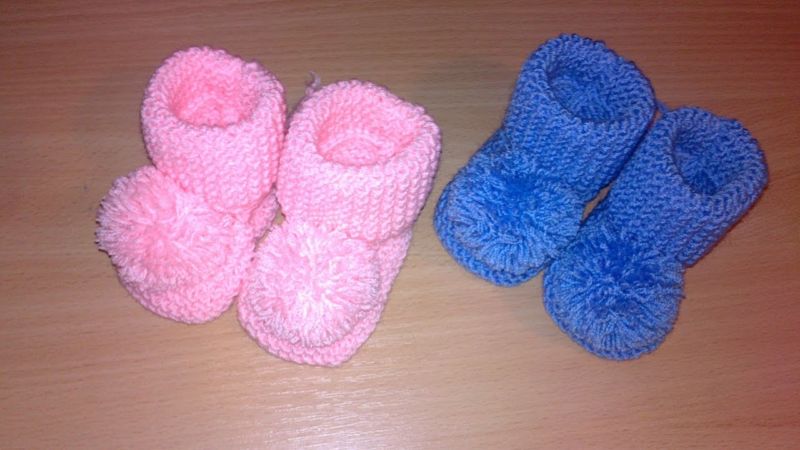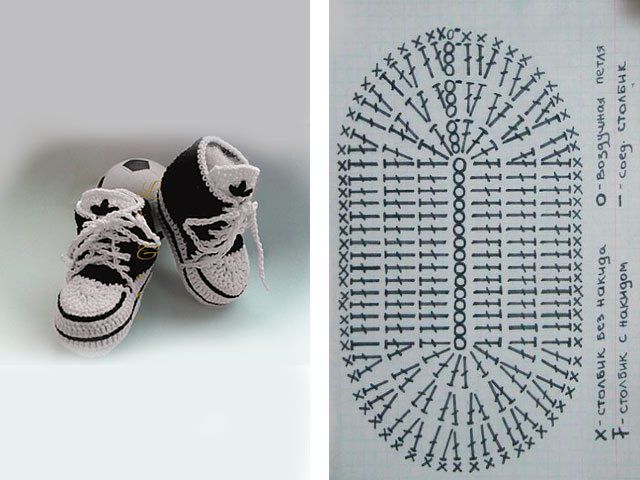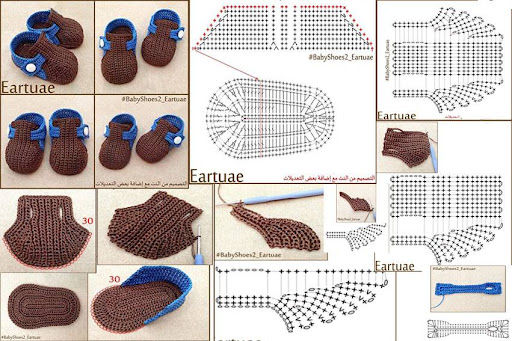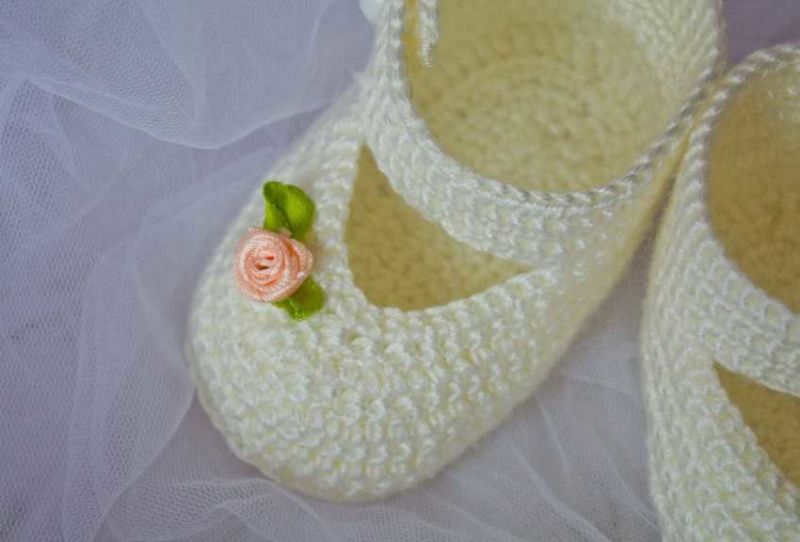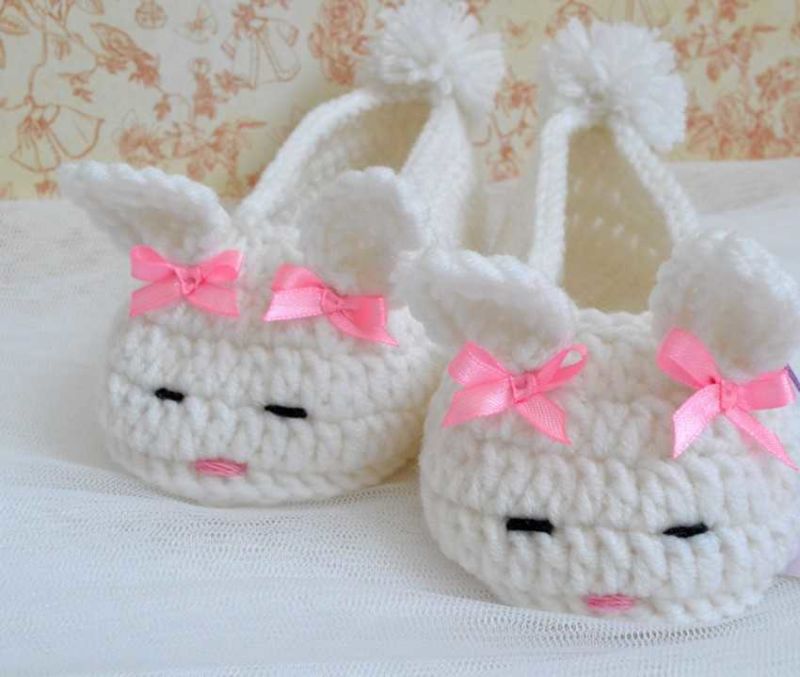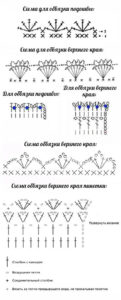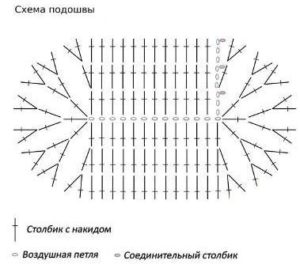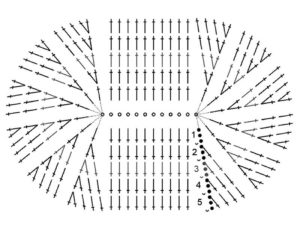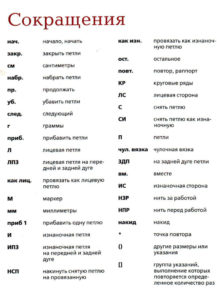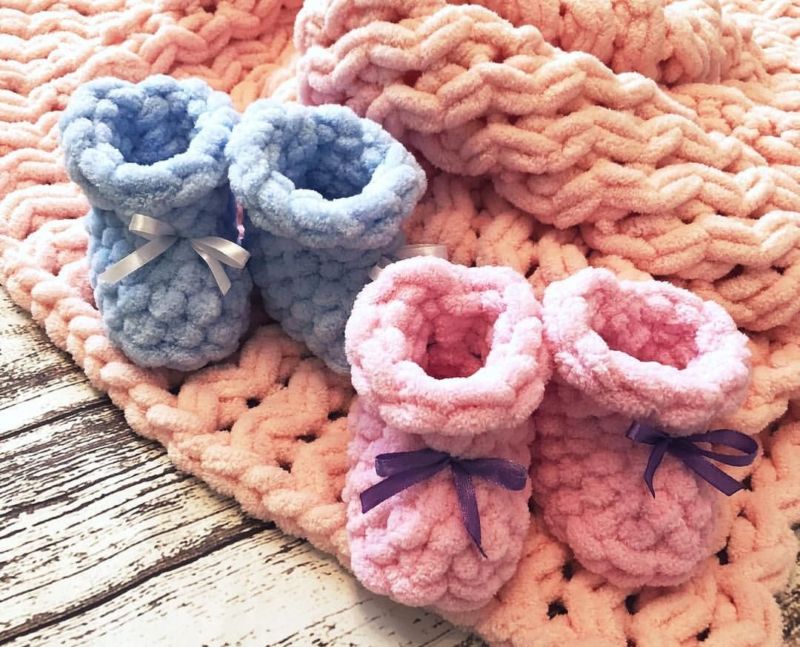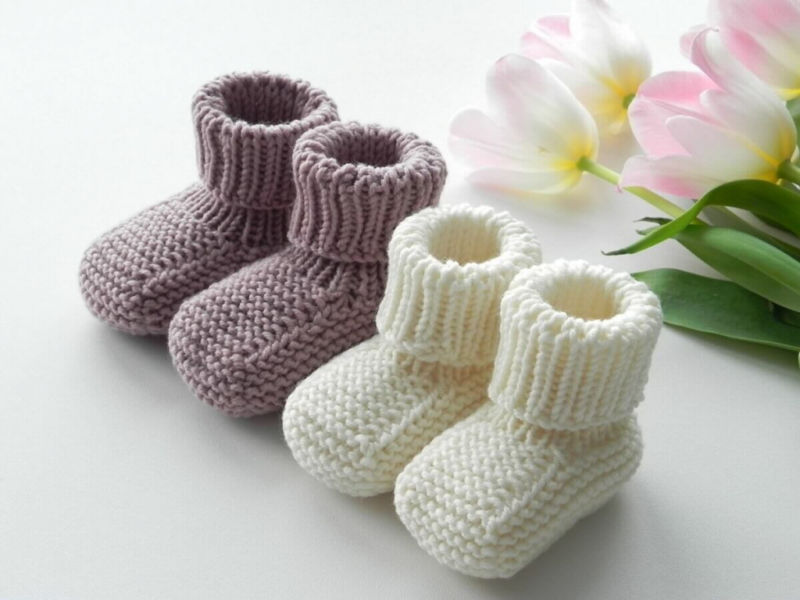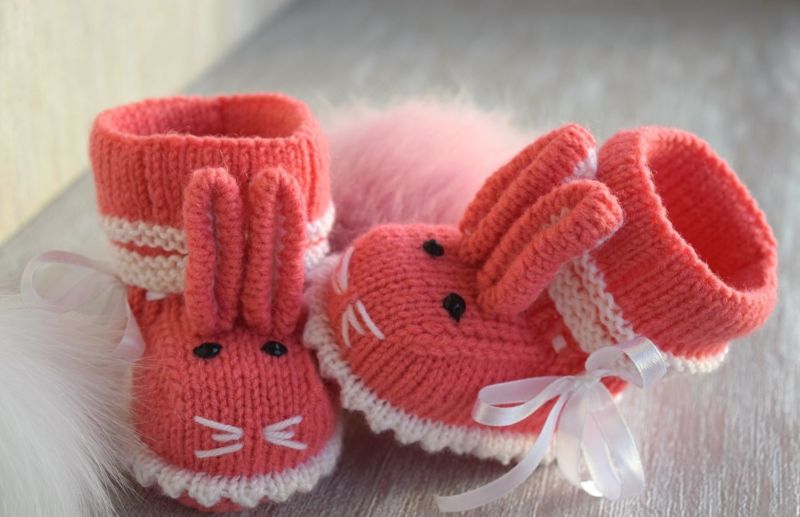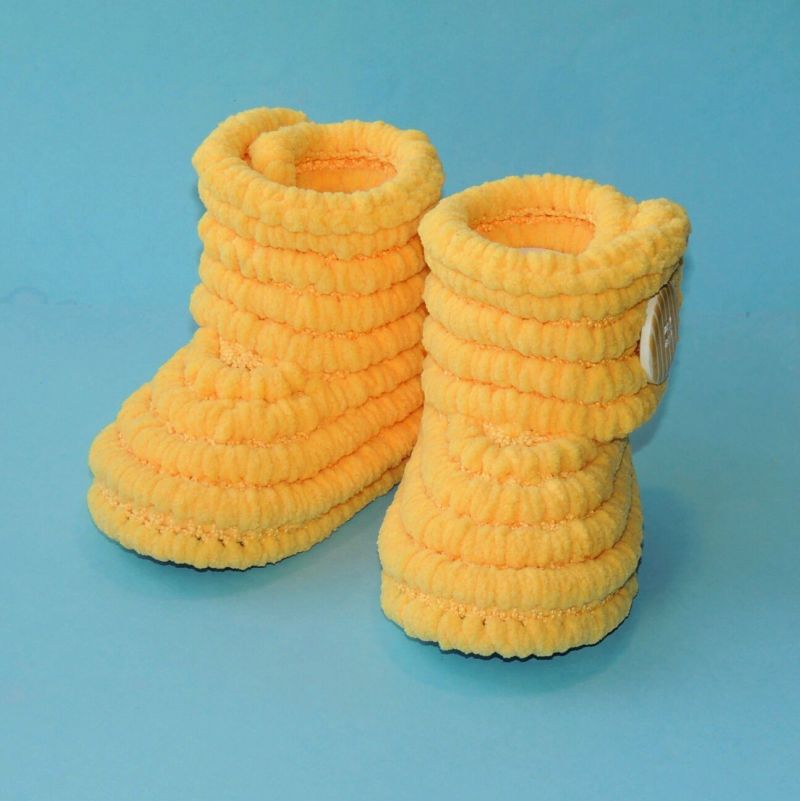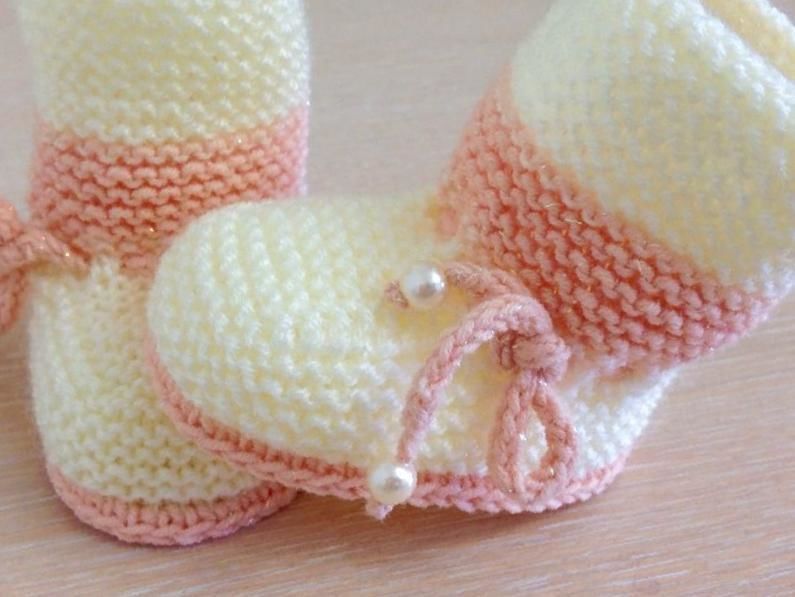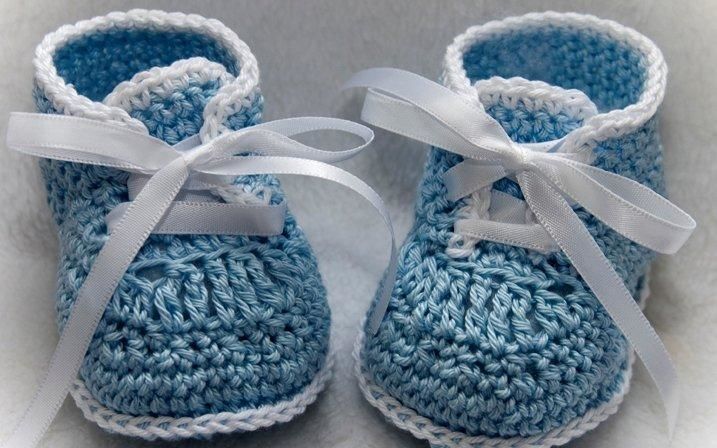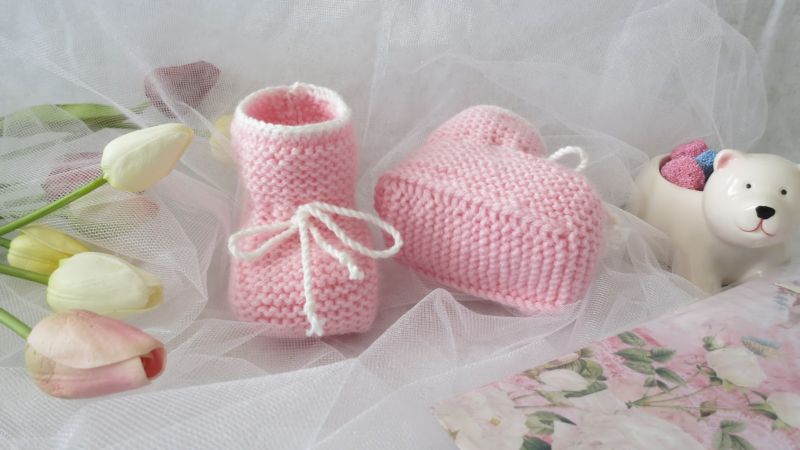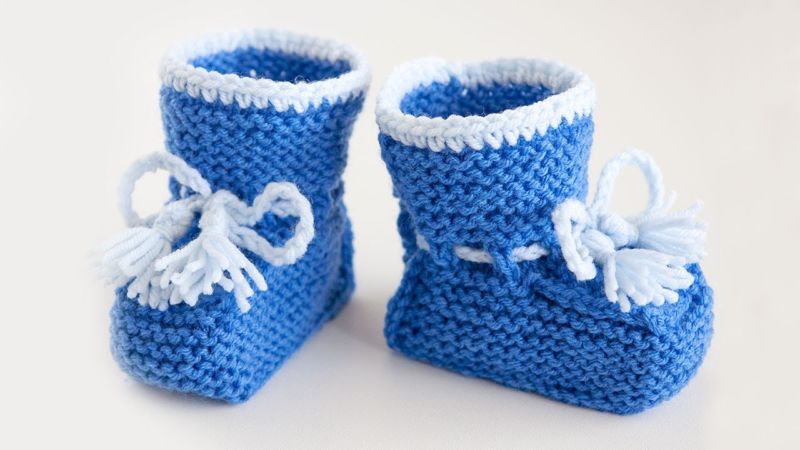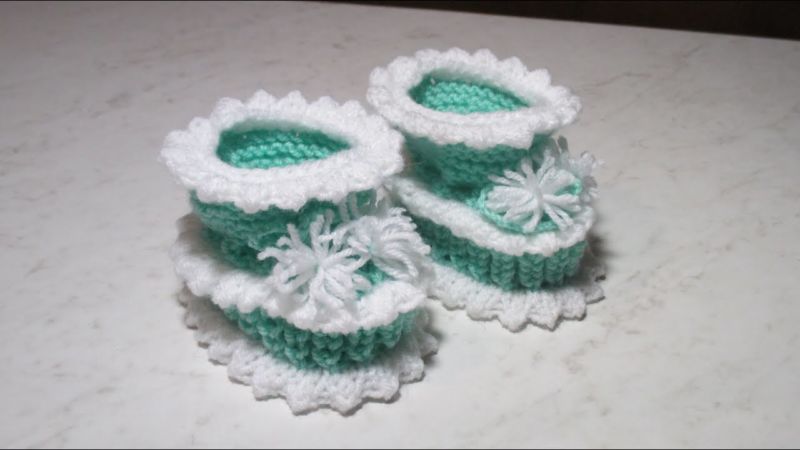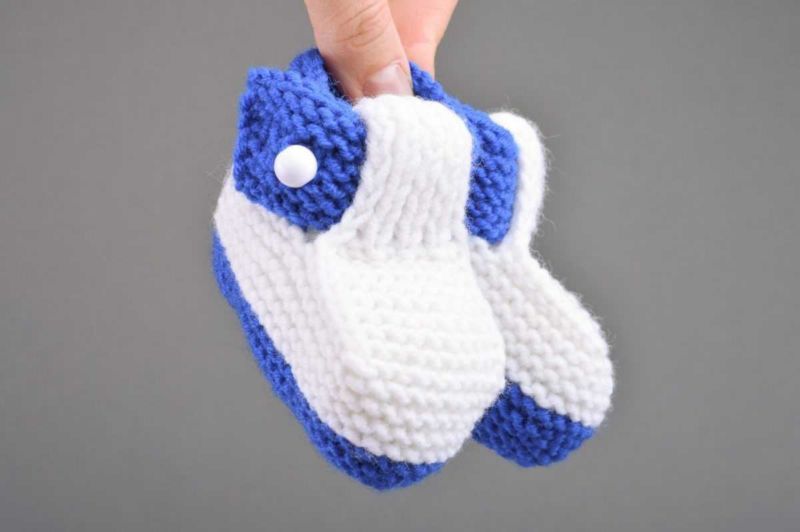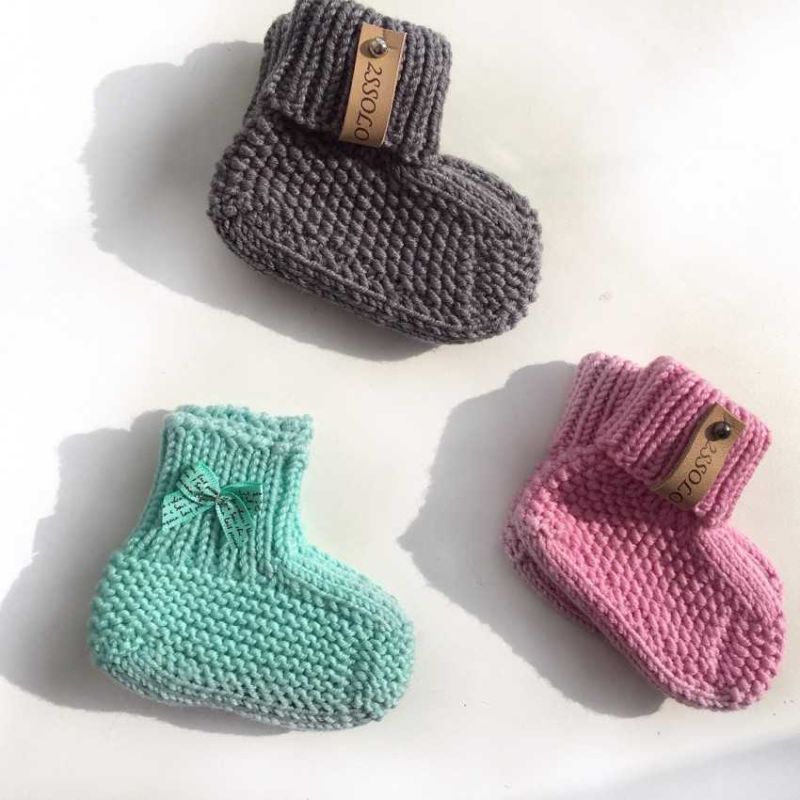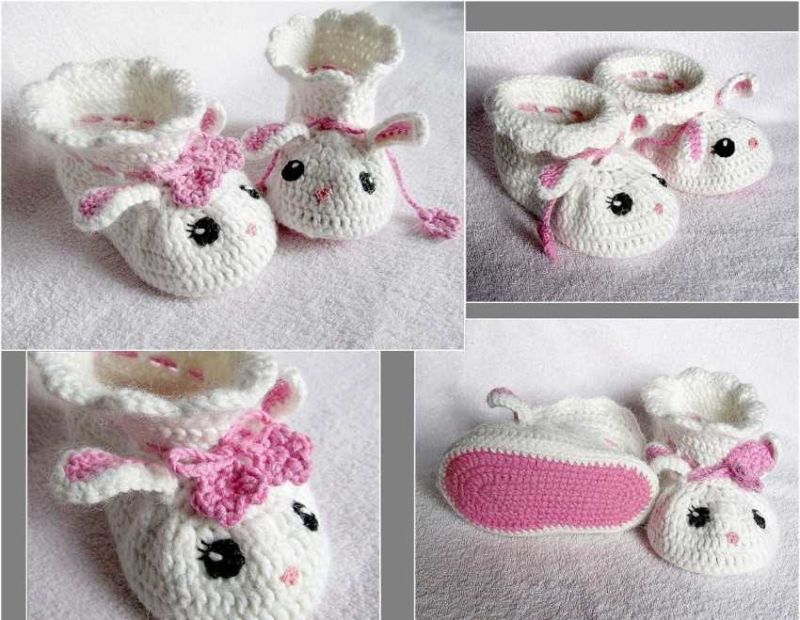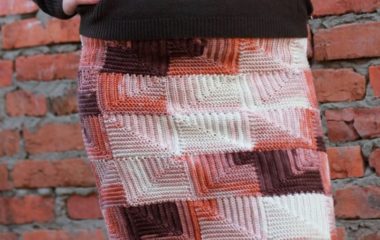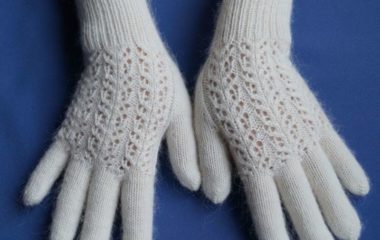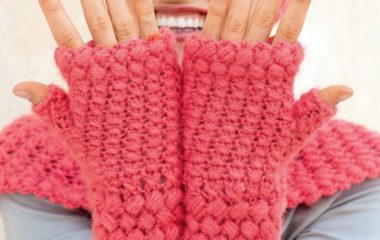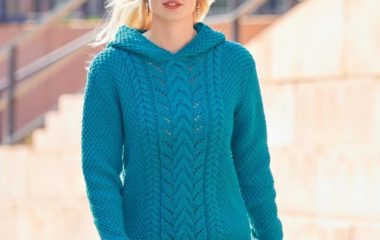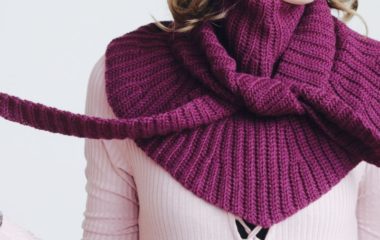Knitting booties by crochet and knitting: beautiful patterns and easy schemes for beginners.
The booties are one of the most pathetic and touching things for a newborn baby.
These first slippers for kids got their name from the famous French shoemaker François Pinet.
At the end of the 19th century, this Parisian shoe designer created soft baby slippers with a webbing.
Over the past 1.5 centuries, the approach to creating the peep-toe has changed a lot. Today, these tiny shoes are usually knitted.
In addition, the appearance of the finished product has also changed. Now it is not only slippers with webbing, but also knitted booties, sneakers, etc.
The booties can take on any shape. It all depends on the flight of fancy of the needlewoman. And inspiration can always be found in various thematic master classes.
Description and components of crocheted booties for children
Creating slippers for babies from yarn is a very laborious activity. After all, the finished thing is very small, and its constituent parts its smaller.
Regardless of the chosen shape, the finished product consists of 4 main parts:
- cuff;
- toe;
- skirt;
- outsole.
- Making slippers for baby, as a rule, begins with the cuff. In most instances, this detail is knitted in a circle, elastic band 1/1. However, in some works, such as sneakers, the masters deviate from this rule and the top area is knit with a gap.
In addition, the top is often the main emphasis. In this case, this element is knitted with a relief or openwork pattern, often using multicolored threads.
The toe is the next detail of the tiny shoe. Depending on the chosen model, the toe can be either solid or sewn to the cuff.
It is this element, as a rule, accounts for the main decor of knitted slippers. Often the toe is decorated with a scythe pattern and other relief patterns. In addition, often the use of sewn decorative elements: beads, rhinestones, ribbons, pompoms and other textile decor.
The toe usually accounts for about 40% of the cuff stitching.
The edging of children's handmade shoes imitates the sole of the shoe. It is this detail that determines how well the finished thing will sit on the foot.
For a normal child's foot, without features, the height of the board is 1-1.5 centimeters, the patches are distributed on the principle of 20% on the front and back areas, 30% - on the sides.
Regardless of the chosen form and whether the edge is solid or sewn, it is always knitted in a circle.
The design of this element is usually minimalistic. Needlewomen mostly prefer to knit the rim with a shawl knit or a rubber band that simulates a scalloped sole.
The base of the handmade darlings also varies in the principle of solid or sewn.
So, one-piece with a board, as a rule, have a seam in the middle of the fabric. Sewn-on ones are knitted in one piece.
Since a baby's foot is very delicate and sensitive, the bootie is preferable with a sewn-in base, knitted in one piece. If the chosen model involves a one-piece sole with a board, the seam should be made outward.
The design emphasis is often on other parts of the piece, so the bottom is usually knit with a shawl knit. Rarely there are works with a sole of contrasting color to the main part of the bootie.
Patterns of knitting booties by scissors for beginners
Making children's shoes with needles - a real art. But it is under the power of almost everyone. After all, among the variety of ideas, you can always choose the one, the technique of which corresponds to the skill of the needlewoman.
To create handmade shoes for the baby with needles:
- actually the needles themselves - they must necessarily correspond to the thickness of the selected threads. Depending on the shape of the slipper and the knitting method, these tools can be circular, sock and classic straight. Often, needlewomen use circular and sock needles to make fiber slippers. The use of classic straight ones is extremely rare;
- Yarn - here an important emphasis should be made on the composition of the fiber. The main parameters when choosing are hypoallergenic and tactile qualities of raw materials. Therefore, wool is not suitable for creating warm handmade knickers. It is quite prickly for the baby's delicate feet and, in addition, can cause allergies. Therefore, when making a gift for a baby born in the cold season, you should opt for high-quality acrylic or microfiber. If the naturalness of the material is the main point, it is better to prefer merino wool. For summertime handmade shoes, cotton or the same acrylic will do fine;
- A darning needle - with its help, if necessary, the details of the finished thing will be sewn;
- decorative elements.
Simple model
The simplest option - classic slippers smooth knitting with a webbing. Such a product under force to knit even a novice needlewoman.
- As a rule, such instances are knitted by simple shawl knitting in a circle as a whole^.
- That is, initially the cuff is knitted in a circle. Then 40% of the work is put aside on the sock and the toe piece is knitted.
- The remaining 60% of the cuff stitches remain on the needles (circular or sock - it doesn't matter) until the next step.
- Next, the loops at the end of the crotch is not closed, on the sides of the new loops are gained at the rate of 1 row = 1 stitch.
- Then collect the loops of the cuff, the side and center loops of the toe and begin to knit the edge.
- Hemline knit by dividing into 2 zones, gradually reducing the number of loops. As previously written, the seam of the product in this case should be made outside. This will save a baby's leg from unnecessary friction.
- Decorativeness of such models is achieved by decorating and using threads of contrasting colors. The use of beads, beads, decorative flowers, figures, ribbons, laces, pompoms is quite acceptable.
Booties .
Work made in the form of boots will be a great accessory for the little ones in the cold season.
The upper part of such knitted boots is much higher than the classic versions and imitates the boot's cuff.
On the Internet it is easy to find a lot of master-classes on creating boots out of yarn, as in the form of video tutorials, and schemes with detailed descriptions.
Tie a bootie is not difficult even for beginner needlewomen. The main thing to understand the peculiarities of making such a model.
The principal difference is that the knitting of the product starts from the bottom up, from the base to the cuff. And not vice versa, as is customary to knit classic versions.
This is the only model in which the use of patent patterns is justified. In other works, the size of the cuff simply will not allow to knit a full multicolored pattern.
Model with a harness
Shoes with a transverse braid-braid on the upper half of the shoe look spectacular.
The cuff of such handmade slippers is knitted in cross direction and stitched at the back of the shoe. To do this, the number of stitches is dialed based on a given width of the cuff. Element is knitted in a straight line with classic tools of length equal to the girth of the future accessory cuff
Braid-braid is made by crossing behind and in front of the main fabric 2 strips of loops. As a rule, 2 to 4 strips are intertwined.
Braid
A very popular knitting version of children's sandals.
The popularity of this method of knitting is that the pattern is not much harder than a simple handmade slippers related shawl knitting, and they look very impressive.
The pattern is very simple and consists of alternating the front and back stitches in a staggered pattern. The difference from the pearl pattern, which is knitted with this interleaving of 1 * 1 is that the "squares" is larger. often use the pattern 4 * 4 or 2 * 2.
Socks
Perhaps the most practical option for children's knitted shoes.
This shape is the most comfortable for the baby because it has no seams or extra decorative details.
In addition, they are best held on a child's foot.
Socks look great because of the monochrome color or, conversely, well chosen combination of colors.
Often the top of such models are knit slightly longer than usual. In this case, the socks can be decorated with a patent pattern.
Seamless .
Seamless pinelets are certainly the most comfortable for the baby's delicate feet.
There are many ways to make seamless knitted slippers.
And if you knit the top part without stitches under force even inexperienced needlewoman, the whole knitted with a seamless edging requires possession of a certain skill.
Thus, experienced knitters advise to continue knitting on the needle, which was used to form the end of the toe. The knitting will go straight and backwards.
In doing so, it is necessary to pick up 1 stitch from the side spokes together with the first and last stitch in the row. Next, when the knitting has reached the heel, you need to join the two fabrics with a darning needle.
Even more spectacular look booties with transverse volume braid on the cuff.
The cuff of such handmade-soles also knit in transverse direction and sewn around the back of the shoe.
The plait is made by crossing the loops behind and in front of the main fabric, depending on the pattern. This will require an additional tool with 2 sharp ends.
The difference from crochet booties with a harness is that more than 2 strips of loops can be crossed.
Crochet booties
Crochet slippers turn out seamless. In this case, and in this case is an advantage of crochet.
Easy option
The easiest version of creating slippers from yarn crochet begins with the sole:
- To do this, a chain of air loops is recruited. The next step is to tie off with stitches.
- Another component of the pattern, the semi-colon, is used to tie the hems. In addition, after 4 rows of the board, you must begin to lose loops.
- With a gradual reduction of the loops, the work narrows to the top in the form of a bootie.
- Next, you can knit the cuff in a circle without adding stitches or finish the product by tying the edge "rachetskogo step.
Sandals .
You can knit in any way, including the easiest.
The main difference is that the shoe ends quite low, leaving a deep neckline. Imitation knitted sandal strap can be knitted from a chain of air loops, tying the next few rows of columns with a squeeze.
The clasp can serve as a bright button, crochet color, a bead or any other decorative element.
In addition, on the World Wide Web are very popular master classes on knitting open sandals. Here the sole is knitted in the traditional way, then 1 or 2 straps and the ankle band are knitted with a shawl knit.
Such an accessory will be a wonderful addition to the closet of "summer" babies.
Accordingly, the yarn for sandals is better to choose with a high content of cotton.
Booties with a pompom
The pompom for knitted handmade slippers can be made in the old grandfather's way, using a template of thick cardboard, as well as by applying a modern set for needlework "tenerife" with a mass of reusable templates.
In the first case, a circle of desired diameter is cut out of dense cardboard, a hole is made in the middle. In fact, the thickness of the resulting rim will be equal to the diameter of the future pompon.
The yarn is evenly and in the same direction wrapped around the cardboard rim. Then use a needle with the same yarn to gather all the resulting bends on the inside of the circle and tighten a little. Then cut from the outside and finally tighten the connecting thread and trim off the protruding threads.
Specialized pom-pom kits have a pattern that consists of a circle with pry bars, for which you need to attach the thread and a central pin that forms the base of the pom-pom.
Booties
Booties are crocheted much higher than sandals. The toe pattern often imitates a scalloped sole.
Shoelaces for boots can be made from ready-made harness, satin ribbon or knit yourself a chain of air loops.
Based on the fact that such products turn out to be very closed, it is better to knit them from a thick warm yarn: microfiber, acrylic or merino wool.
Slippers with straps.
This is more of a dressy kind of booties, not suitable for everyday wear.
Knitted slippers are more often used in the outfits of little princesses for festive events and photo shoots.
Such accessories are decorated with satin bows, beads and beads.
The strap can be both connected from the same yarn as the entire product and decorated with decorative elements, so it may well be made of ribbon lace, satin ribbon.
There are a great variety of models and knitting techniques. And the special charm of this kind of needlework gives a variety of decorations.

